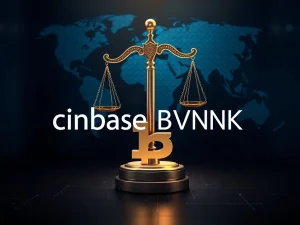Landmark STABLE Act: US House Committee Greenlights Stablecoin Regulation – A New Era?

Exciting news for the crypto world! The US House Financial Services Committee just took a significant step towards regulating stablecoins. The STABLE Act, a bill designed to establish a framework for these increasingly popular digital currencies, has successfully passed through the committee. What does this mean for the future of crypto and your investments? Let’s dive into the details of this potentially game-changing legislation.
What is the STABLE Act and Why Does it Matter for Stablecoin Regulation?
The Stablecoin Transparency and Accountability for a Better Ledger Economy (STABLE) Act is a Republican-backed bill that recently cleared a crucial hurdle by passing the US House Financial Services Committee with a 32-17 vote on April 2nd. This bill is specifically focused on establishing clear rules for payment stablecoins – cryptocurrencies pegged to the value of fiat currencies like the US dollar. But why is this legislation so important?
- Increased Transparency: The STABLE Act aims to ensure stablecoin issuers are transparent about their operations and how they back the value of their tokens. This could bring much-needed clarity to a market that has sometimes been criticized for its opacity.
- Consumer Protection: By setting regulatory standards, the act seeks to protect users of stablecoins from potential risks associated with these digital assets. This is crucial for fostering trust and wider adoption.
- Financial Innovation: While regulation can sometimes be seen as stifling innovation, proponents of the STABLE Act argue that it will provide a clear framework for responsible financial innovation within the stablecoin space.
Key Provisions of the STABLE Act: What’s Inside?
While the full details will unfold as the bill progresses, the core aim of the STABLE Act is to create a regulatory perimeter around stablecoins. Here’s a glimpse at what the act is likely to address:
- Disclosure Requirements: Issuers will likely need to provide detailed information about their business operations, reserve assets, and mechanisms for maintaining the peg to the underlying fiat currency.
- Reserve Requirements: The act may specify the type and quality of assets that stablecoin issuers must hold in reserve to back their tokens. This is crucial for ensuring that each stablecoin is truly redeemable for its pegged value.
- Regulatory Oversight: The bill will likely designate a regulatory body to oversee stablecoin issuers and ensure compliance with the new rules. This could be the existing financial regulators or a new entity.
It’s important to remember that the STABLE Act is not the only piece of crypto legislation in the works. The GENIUS Act, for example, is another bill making its way through Congress, focusing on oversight and reserve rules for stablecoin issuers. This indicates a growing momentum towards establishing a comprehensive regulatory framework for the crypto industry in the US.
What are the Potential Impacts of Stablecoin Regulation?
The passage of the STABLE Act could have far-reaching consequences for the cryptocurrency ecosystem. Let’s explore some potential impacts:
| Potential Impact | Description |
|---|---|
| Increased Institutional Adoption | Clear stablecoin regulation could pave the way for greater institutional investment in stablecoins and the broader crypto market, as regulatory clarity reduces perceived risks. |
| Market Stability | By ensuring robust reserves and transparency, the act could contribute to greater stability within the stablecoin market, reducing the likelihood of de-pegging events. |
| Innovation and Competition | A well-defined regulatory framework can foster healthy competition and innovation within the stablecoin sector, encouraging the development of new and improved products and services. |
| Compliance Costs | Issuers may face increased compliance costs associated with meeting the requirements of the STABLE Act, potentially impacting smaller players in the market. |
| Global Regulatory Landscape | The US’s approach to stablecoin regulation could influence regulatory developments in other jurisdictions, shaping the global landscape for digital assets. |
Will the STABLE Act Pass a Full House Vote?
The successful committee vote is a significant step forward for the STABLE Act, but it’s not the final hurdle. The bill now moves to the full House of Representatives for a vote. While the committee passage indicates bipartisan support, the outcome of the full House vote remains uncertain. Factors that could influence the vote include:
- Political Dynamics: The level of bipartisan support in the House and the broader political climate will play a crucial role.
- Lobbying Efforts: Both proponents and opponents of the bill are likely to engage in lobbying efforts to influence lawmakers.
- Amendments and Revisions: The bill could be subject to amendments and revisions as it moves through the legislative process, potentially altering its scope and impact.
Stay Tuned for Further Updates on US House Committee and STABLE Act Progress
This is a developing story, and the crypto community is watching closely as the STABLE Act progresses through the US legislative process. The outcome could significantly shape the future of stablecoins and the broader cryptocurrency market in the United States and beyond. Keep checking back for further updates and analysis as this important piece of US House committee legislation moves forward. We’ll continue to provide insights into the evolving regulatory landscape and its implications for you, the crypto enthusiast and investor.
Conclusion: Embracing the Future of Crypto with Cautious Optimism
The STABLE Act represents a pivotal moment in the journey towards mainstream crypto adoption. While regulatory frameworks can sometimes feel restrictive, in the case of stablecoins, clear and sensible rules could be the key to unlocking their full potential. By fostering transparency, protecting consumers, and encouraging responsible innovation, stablecoin regulation like the STABLE Act could pave the way for a more robust, secure, and ultimately, more accessible digital financial future. The journey is just beginning, but the direction is clear: regulation is coming, and with it, perhaps, a new era of crypto maturity.







